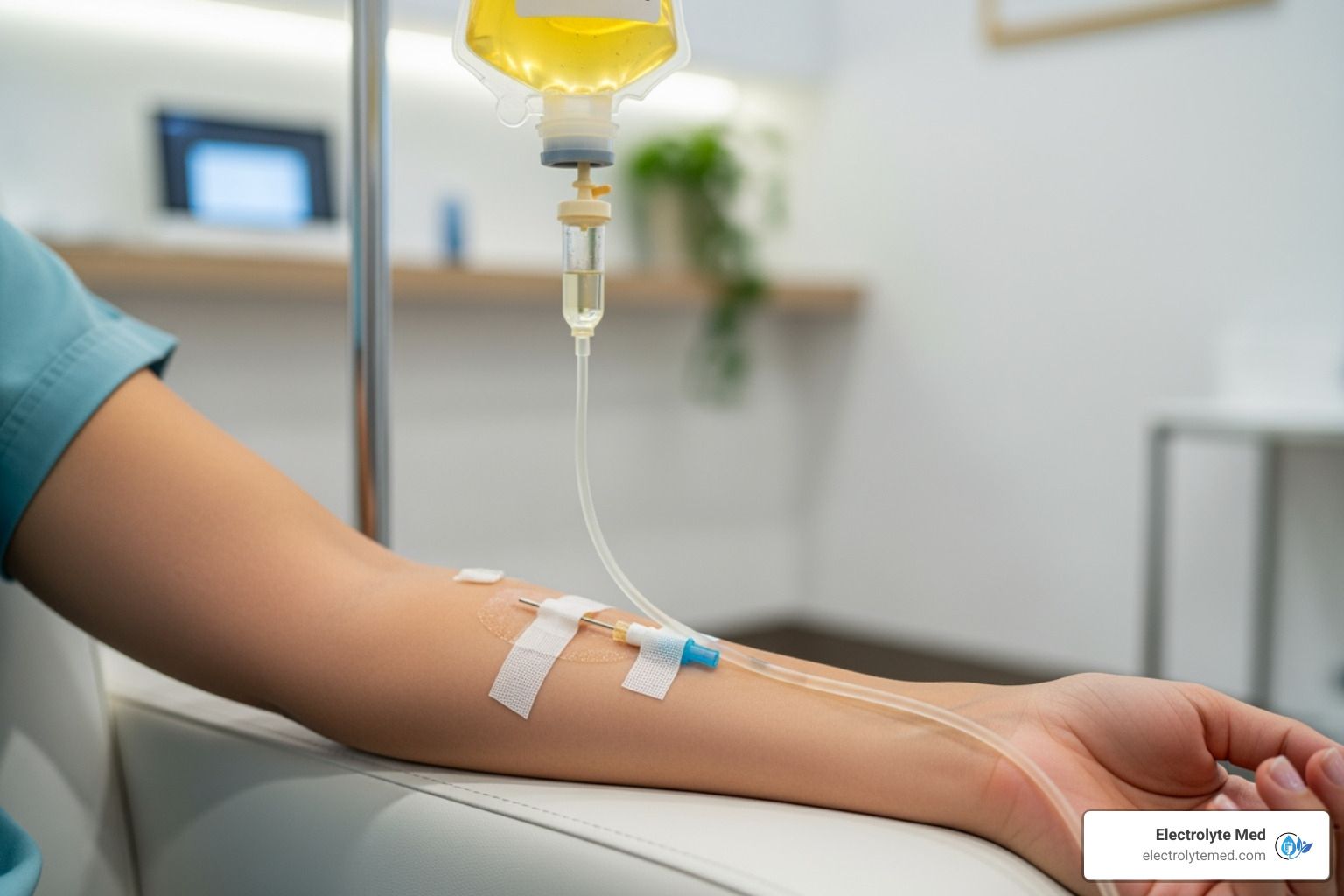Understanding the Role of Ketamine Therapy in Treating Depression
Depression affects millions of people worldwide, and while standard therapies like medication and talk therapy can be helpful, they don't work for everyone. This has led researchers and healthcare professionals to explore alternative treatments. One such emerging option that has been gaining attention is Intravenous (IV) therapy. Originally used for nutritional deficiencies and hydration, IV therapy is now being studied for its potential benefits in mental health treatment, particularly depression.
As innovative as it sounds, IV therapy might just be the complementary treatment you need on your journey to mental well-being. This article delves into how IV therapy is being used to combat depression, examining the science behind it and evaluating its potential efficacy. If you're exploring new ways to address your mental health, understanding this alternative could provide a new perspective on battling depression.
The Rising Conversation Around IV Therapy and Mental Health
In recent years, the conversation around mental health has shifted to include innovative and alternative approaches beyond traditional therapy and medication. For many individuals battling debilitating conditions like major depression, anxiety disorders, and post-traumatic stress disorder, finding an effective treatment for depression can be a long and challenging journey. A significant number of people experience treatment-resistant depression, where standard antidepressants and therapies simply do not provide adequate relief. This is where a promising new area of focus, IV therapy, has emerged. While not a cure, a growing body of research and clinical experience suggests that certain types of intravenous infusions may offer a rapid and effective way to address persistent depressive symptoms.
Understanding the Role of Ketamine Therapy
One of the most talked-about forms of intravenous infusions for mental health conditions is Ketamine therapy. Originally an anesthetic used in medical settings, ketamine has gained attention for its rapid-acting antidepressant effects. Unlike traditional antidepressants, which can take weeks or even months to show an effect, a ketamine infusion can provide relief from depressive symptoms within hours. This makes it a particularly compelling option for those in crisis or those who have exhausted other avenues. The primary form of this treatment is an intravenous infusions of a carefully controlled dose of ketamine, often referred to as a ketamine infusion or IV ketamine.
Understanding the Role of Ketamine Therapy
One of the most talked-about forms of intravenous infusions for mental health conditions is Ketamine therapy. Originally an anesthetic used in medical settings, ketamine has gained attention for its rapid-acting antidepressant effects. Unlike traditional antidepressants, which can take weeks or even months to show an effect, a ketamine infusion can provide relief from depressive symptoms within hours. This makes it a particularly compelling option for those in crisis or those who have exhausted other avenues. The primary form of this treatment is an intravenous infusions of a carefully controlled dose of ketamine, often referred to as a ketamine infusion or IV ketamine.
How IV Ketamine Works: A Look at the Brain
The exact mechanism of action for IV ketamine is still a subject of ongoing research, but it is believed to be fundamentally different from traditional antidepressants. While medications like SSRIs primarily target serotonin, Ketamine therapy works on the brain's glutamate receptors. Glutamate is a key neurotransmitter involved in brain activity and the formation of new neural connections. By influencing these glutamate receptors, ketamine infusions can help to rapidly rewire neural pathways, creating new connections and promoting neuroplasticity. This process is believed to help correct the underlying neurological issues associated with treatment-resistant depression.
Exploring the Neuroplasticity Induced by Ketamine
Neuroplasticity is the brain's remarkable ability to reorganize itself by forming new neural connections throughout life. This capacity is crucial for recovery from brain injuries, learning new skills, and potentially overcoming mental health challenges like depression. The rapid enhancement of neuroplasticity via ketamine infusions is one of the main reasons why this therapy may effectively combat treatment-resistant depression.
Studies suggest that ketamine induces the release of brain-derived neurotrophic factor (BDNF), a protein that supports the survival of existing neurons and encourages the growth of new ones. This increase in BDNF enhances the brain's adaptability and resilience, which may counteract depressive symptoms. Ketamine's action on glutamate receptors—a critical component in synaptic plasticity—further strengthens these effects
The Clinical Protocol for Ketamine Infusions
A typical course of ketamine treatment involves several infusions administered over a few weeks. While the exact number of sessions can vary depending on the individual’s response and treatment plan, most protocols begin with six infusions over two weeks as a standard induction phase. Maintenance infusions may be necessary for ongoing relief, though their frequency and duration are tailored to each patient's needs.
Before beginning ketamine infusions, a comprehensive evaluation by a medical professional is essential. This assessment typically includes a detailed psychiatric history, physical examination, and any necessary lab tests to ensure no contraindications for treatment exist. Patients are usually advised to avoid eating or drinking for several hours before each session to prevent nausea, a common side effect of the infusions.
Each ketamine session usually takes place in a controlled medical setting, ensuring patient safety and immediate access to medical care if needed. During the infusion, which generally lasts about 40 minutes, patients are monitored for vital signs, such as blood pressure and heart rate, and any adverse reactions. Some experience mild dissociative or hallucinatory effects due to ketamine's properties as an anesthetic, but these often subside shortly after the infusion ends.
Post-infusion, patients require monitoring for a short period to ensure they have returned to their baseline state. Some individuals may experience side effects like dizziness or fatigue, so it's generally recommended that they have someone accompany them to the appointment and drive them home afterward.
Eligibility Criteria for Ketamine Infusion Therapy
Not everyone with depression is a candidate for ketamine infusion therapy. This treatment is usually considered for individuals with treatment-resistant depression, meaning they've tried several standard antidepressant medications and therapies without significant improvement. Individuals who have not responded to at least two different types of antidepressant treatments are often the primary candidates for consideration.
Additionally, potential patients are evaluated for certain medical conditions and coexisting psychiatric disorders that might influence the therapy's efficacy or safety. For example, individuals with uncontrolled hypertension, a history of substance abuse, or certain cardiovascular issues might face a higher risk of complications with ketamine therapy.
Medical providers also assess factors such as a patient's recent substance use and overall mental stability. Those with active psychosis or untreated bipolar disorder may not be ideal candidates, as ketamine can exacerbate these conditions. It's crucial that patients seeking this treatment maintain open communication with their healthcare provider to ensure a comprehensive evaluation of risks versus benefits.
Benefits and Limitations of Ketamine Therapy for Depression
Benefits
- Rapid Relief: Unlike traditional antidepressants, which can take weeks to exhibit effects, ketamine infusion may provide relief within hours to days, offering hope for those in acute distress.
- Alternative for Treatment-Resistant Cases: For patients who have struggled to find relief through medications like SSRIs or therapy, ketamine presents a viable alternative.
- Potential for Long term Improvement: Some studies suggest that ketamine may have lasting benefits, with some patients experiencing significant mood improvements weeks to months after treatment, especially when followed up with maintenance sessions.
- Improved Cognitive Function: In addition to mood enhancement, some patients report improvements in cognitive functions like attention and memory, which are often impaired in depression.
- Reduced Suicidal Ideation: For those struggling with severe depression and suicidal thoughts, ketamine infusion therapy has been shown to have a quick and substantial impact, reducing the intensity of these thoughts after just one or two sessions.
Potential Benefits and Side Effects
The potential benefits of intravenous ketamine therapy are significant. For many with treatment-resistant depression, it can offer rapid and profound relief from symptoms. Studies have also explored its use for other mental healthchallenges, including bipolar disorder, anxiety disorders, and post-traumatic stress disorder. However, like any powerful medication, IV ketamine comes with potential side effects. These can include a temporary increase in blood pressure and heart rate, as well as feelings of dissociation, dizziness, and blurred vision during the infusion. The team at your chosen ketamine clinic will monitor your blood pressure and other vitals closely throughout the session as part of your treatment plan.
It is important to understand that IV ketamine is not a permanent cure. Its effects are often a "reset" for the brain, and many patients require a series of treatments followed by maintenance infusions as part of a long-term treatment plan.
Complementary IV Therapies for Overall Well-being
While IV ketamine is a specialized treatment, there are other forms of IV therapy that can support your overall mental health as part of a holistic wellness strategy. For example, maintaining proper hydration is crucial for cognitive function, and IV hydration can help alleviate symptoms of fatigue and improve focus. For a much-needed mental boost, a specific IV blend can help with energy focus. Such therapies deliver essential vitamins, minerals, and amino acids directly into the bloodstream, bypassing the digestive system for immediate benefit. For those dealing with physical ailments that can impact mood, such as migraine headaches, a specialized migraine IV treatment can provide targeted relief.
A Look at Other Supportive IV Treatment
Beyond those for mood, other IV therapy services can support a person's physical health, which in turn benefits their mental health. For those struggling with chronic pain, intravenous infusions may offer relief that complements other treatments. Similarly, our Recovery IV Treatment can help with physical recovery from exercise or stress, supporting a healthier body and mind. It is crucial to remember that these are not substitutes for professional mental health care, but they can be valuable tools as part of a comprehensive treatment plan. To make these beneficial services more accessible, membership programs are often available.
Conclusion: A Measured Approach to Mental Health
The use of IV therapy for mental health conditions is an evolving field, with ketamine treatments at the forefront. While not a first-line approach, for individuals facing the severe challenges of treatment-resistant depression, it offers a powerful and rapid-acting avenue for hope. It's a testament to the ongoing innovation in the field of mental health. However, these treatments should always be administered under the close supervision of a medical professional as part of a carefully considered treatment plan. If you are considering IV therapy for depression symptoms or other mental health concerns, it is vital to consult with a specialist to discuss the potential benefits and risks.




